
What Is an AI Avatar, In 2024

What Is an AI Avatar?
Part 1. What exactly is an AI avatar?
AI avatar refers to a digital representation or embodiment of an individual that is created and controlled using artificial intelligence techniques. It is an interactive virtual character that can simulate human-like behaviors, emotions, and interactions.
AI avatars are often designed to resemble human appearance and can be used in various applications, such as virtual assistants, customer service representatives, virtual companions, or virtual reality environments.
AI algorithms and technologies, including natural language processing, computer vision, and machine learning power these avatars. They can understand and respond to user inputs, engage in conversations, express emotions through facial expressions and gestures, and provide personalized interactions.
AI avatars aim to enhance human-computer interactions by creating a more engaging and immersive experience. They can be utilized in diverse fields, including entertainment, education, healthcare, and more, to provide interactive and personalized experiences to users.
Part 2. What’s the characteristics and advantages of AI avatars?
Compared to traditional avatar representations, AI avatars are more “human-like.” Their most notable characteristic is their possession of human-like appearance. AI avatars are designed to resemble human beings in their appearance, including facial features, expressions, and body movements. This helps create a sense of familiarity and relatability for users. Hence, they are interactive and responsive, as well as capable of understanding and responding to user inputs, whether through text, speech, or gestures. They can engage in conversations, answer questions, and provide relevant information or assistance.
Meanwhile, AI avatars also have the ability to learn adaptively and can learn from user interactions and adapt their responses over time. They can improve their understanding, language capabilities, and behavior based on user feedback, making their interactions more effective and tailored to individual preferences.
Moreover, AI avatars have great advantages, such as 24/7 availability and consistency. They can be available round the clock, providing assistance and information anytime. This ensures continuous support and access to services without limitations imposed by human availability. In the meantime, they can maintain a consistent tone, language, and behavior across interactions, eliminating variations that may occur with human operators.
Part 3. What’s the application area of AI avatars?
AI avatars have a wide range of applications across various fields. Some common areas where AI avatars are used include:
1. Virtual Assistants
AI avatars can serve as virtual assistants, providing information, answering questions, and assisting with tasks in a conversational manner. Examples include Apple’s Siri, Amazon’s Alexa, and Google Assistant.
2. Customer Service
AI avatars are utilized in customer service applications, where they can engage with customers, handle inquiries, and provide support in a more interactive and personalized way. They can assist with product recommendations, troubleshooting, and order processing.
3. Education
AI avatars are used in educational applications to create interactive learning experiences. They can act as virtual tutors, guiding students through lessons, providing explanations, and adapting to individual learning needs.
4. Entertainment
AI avatars play a role in entertainment applications such as virtual reality (VR) and video games. They can be characters within a game or interactive companions that respond to user actions and emotions, creating immersive and engaging experiences.
5. Healthcare
AI avatars find applications in healthcare for patient education, therapy, and mental health support. They can provide information about medical conditions, assist with medication reminders, and offer emotional support.
6. Training and Simulation
AI avatars are used in training simulations for various industries, including military, aviation, and healthcare. They can replicate realistic scenarios, allowing trainees to practice skills and decision-making in a safe and controlled environment.
7. Social Media and Chat Applications
AI avatars are integrated into social media platforms and chat applications, providing users with personalized interactions, recommendations, and entertainment.
The applications of AI avatars are continually expanding as technology advances, offering new possibilities for interactive and immersive experiences in various domains.
Part 1. What exactly is an AI avatar?
AI avatar refers to a digital representation or embodiment of an individual that is created and controlled using artificial intelligence techniques. It is an interactive virtual character that can simulate human-like behaviors, emotions, and interactions.
AI avatars are often designed to resemble human appearance and can be used in various applications, such as virtual assistants, customer service representatives, virtual companions, or virtual reality environments.
AI algorithms and technologies, including natural language processing, computer vision, and machine learning power these avatars. They can understand and respond to user inputs, engage in conversations, express emotions through facial expressions and gestures, and provide personalized interactions.
AI avatars aim to enhance human-computer interactions by creating a more engaging and immersive experience. They can be utilized in diverse fields, including entertainment, education, healthcare, and more, to provide interactive and personalized experiences to users.
Part 2. What’s the characteristics and advantages of AI avatars?
Compared to traditional avatar representations, AI avatars are more “human-like.” Their most notable characteristic is their possession of human-like appearance. AI avatars are designed to resemble human beings in their appearance, including facial features, expressions, and body movements. This helps create a sense of familiarity and relatability for users. Hence, they are interactive and responsive, as well as capable of understanding and responding to user inputs, whether through text, speech, or gestures. They can engage in conversations, answer questions, and provide relevant information or assistance.
Meanwhile, AI avatars also have the ability to learn adaptively and can learn from user interactions and adapt their responses over time. They can improve their understanding, language capabilities, and behavior based on user feedback, making their interactions more effective and tailored to individual preferences.
Moreover, AI avatars have great advantages, such as 24/7 availability and consistency. They can be available round the clock, providing assistance and information anytime. This ensures continuous support and access to services without limitations imposed by human availability. In the meantime, they can maintain a consistent tone, language, and behavior across interactions, eliminating variations that may occur with human operators.
Part 3. What’s the application area of AI avatars?
AI avatars have a wide range of applications across various fields. Some common areas where AI avatars are used include:
1. Virtual Assistants
AI avatars can serve as virtual assistants, providing information, answering questions, and assisting with tasks in a conversational manner. Examples include Apple’s Siri, Amazon’s Alexa, and Google Assistant.
2. Customer Service
AI avatars are utilized in customer service applications, where they can engage with customers, handle inquiries, and provide support in a more interactive and personalized way. They can assist with product recommendations, troubleshooting, and order processing.
3. Education
AI avatars are used in educational applications to create interactive learning experiences. They can act as virtual tutors, guiding students through lessons, providing explanations, and adapting to individual learning needs.
4. Entertainment
AI avatars play a role in entertainment applications such as virtual reality (VR) and video games. They can be characters within a game or interactive companions that respond to user actions and emotions, creating immersive and engaging experiences.
5. Healthcare
AI avatars find applications in healthcare for patient education, therapy, and mental health support. They can provide information about medical conditions, assist with medication reminders, and offer emotional support.
6. Training and Simulation
AI avatars are used in training simulations for various industries, including military, aviation, and healthcare. They can replicate realistic scenarios, allowing trainees to practice skills and decision-making in a safe and controlled environment.
7. Social Media and Chat Applications
AI avatars are integrated into social media platforms and chat applications, providing users with personalized interactions, recommendations, and entertainment.
The applications of AI avatars are continually expanding as technology advances, offering new possibilities for interactive and immersive experiences in various domains.
Easy Tutorial How to Record and Send Talking Emoji for iPhone
Have you noticed the animated emojis in your friends’ messages on iPhone and wondered how to use them yourself? ThisiPhone talking emoji is called Animoji or animated memoji. You can make it talk by recording it on your iPhone.
For those who love to spend their time texting and chatting, this feature can really help add a fun element to your conversations. Just imagine your friends receiving a video of your voice emanating from your animated avatar! If you are curious, let’s seehow to make talking emoji on iPhone .
Part 1. What is iPhone Talking Emoji or Animoji?
Animoji is an Apple feature that transforms specific emoji icons into short, customized animations using your facial expressions and voice. Using Apple’s Face ID facial recognition system, this Apple talking emoji turns you into an animated character that copies your expressions and speech in real time.
You can make and share Animoji with other Apple users through the Messages app. There are over 25 of these iPhone talking emojis available, including your own avatar, poop, panda, pig, robot, and ghost that can mirror your facial expressions.
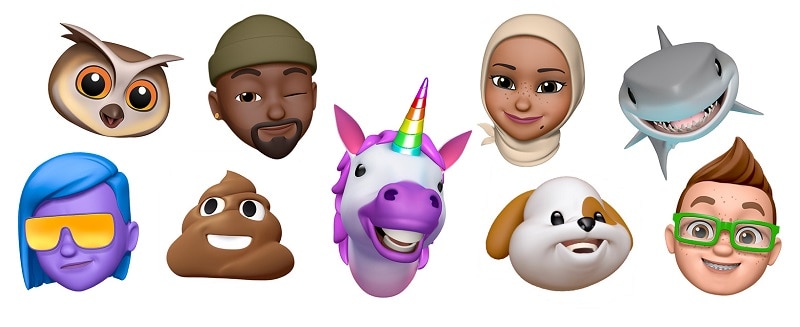
Part 2. How Does iPhone Talking Emoji Work?
Ever tried those fun Snapchat lenses? Thetalking emoji on Apple devices works in a similar fashion to Snapchat lenses. But instead of relying on custom masks from Snapchat, it uses popular emojis.
Animoji takes advantage of the TrueDepth camera system and the iPhone’s internal chip to use Face ID technology. Apple first introduced Face ID in 2017 with the iPhone X. Now, all newer iPhone models come equipped with Face ID.
So you can use and make Animoji on iPhone X or later. You can also use it on the iPad Pro 11-inch or the iPad Pro 12.9-inch (3rd generation) and newer models.
Part 3. How To Make Talking Emoji Using iPhone Recording
Creating your owntalking emoji for iPhone is a straightforward and enjoyable process. With just a few simple steps, you can bring your digital avatar to your messages and add a fun personalized touch to the conversation.
Follow these steps onhow to make talking emoji on iPhone :
Step 1: Launch the Messages app on your iPhone and either start a new message or select an existing conversation.
Step 2: Within the message, tap the Plus icon and select “More” from the menu options.
Step 3: Next, tap the Memoji button and choose “New Memoji” from the subsequent menu.
Step 4: Time to let your creativity flow! Start customizing your Memoji by adjusting various features such as skin tone, hairstyle, eyes, facial hair, accessories, and more to personalize it to your liking.
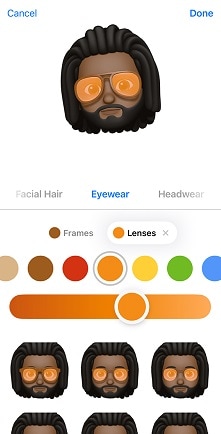
Step 5: After creating your personalized Memoji, find and tap the Memoji button (depicted as a smiling face) on the message. Swipe left to browse and select your Memoji for recording.
Step 6: With your chosen Memoji in place, tap the Record button to commence recording your message. You have a maximum of 30 seconds to record your Animoji. Once done, tap Stop, and then send the animated video with your voice recording to your friend.

Part 4. Recommend: Make iPhone Emoji Photo Talks By Third-Party Tool Directly
Aside from recording an Animoji, you can also make aniPhone talking emoji from an image with Wondershare Virbo . If you feel inconvenient to record your Memoji, you just have to upload your Memoji image, add your audio recording, and Virbo will handle the rest.
Virbo is a versatile video editing tool designed for crafting short videos featuring realistic avatars using AI-generated content (AIGC) technology. One of its standout features is the capability to generate speaking avatars from images through its Photo Talking feature.
Virbo Photo Talking features include:
- Make your Memoji talk from an image
- Ability to voiceover and add your own voice
- Cross-platform compatibility on online, desktop, and mobile applications
- Natural animation and lip synchronization
How to make talking emoji on iPhone easily from an image:
Step 1: Start a New Project
Once you’ve installed Wondershare Virbo , open the app and choose the Talking Photo feature to begin making your Memoji talk.

Get Started Online Free Download
Step 2: Upload Your Memoji Photo
Select “Upload a photo” and pick the Memoji image saved in your camera roll.

Step 3: Customize and Export Your Talking Memoji Video
Enter your desired text and choose a voiceover from the provided options below to create the audio for your video. Alternatively, you can record your own voice by selecting “record audio.”
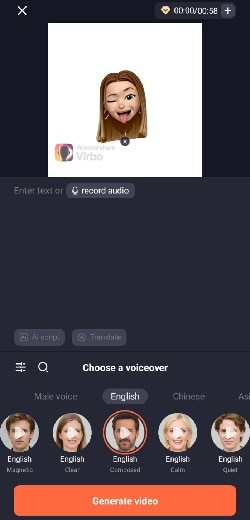
Once you’ve finished editing your video, click “Generate Video” to export your creation. If you need assistance with creating your talking Memoji, you can refer to the video tutorial to make talking emoji for iPhone .
Conclusion
iPhone talking emoji , also known as Animoji, is a feature that uses Apple’s facial recognition technology to animate emoji characters using the user’s facial expressions and voice. This feature was introduced with the iPhone X and has since been expanded to include various emoji characters, including animals, aliens, and even robots.
Users can record short video messages or take photos with these animated emoji characters and send them to their friends to add a fun touch to their communication. You can also use Wondershare Virbo’s Photo Talking feature to make thisApple talking emoji talk from an image.
AI Video Translator | Online
AI Video Translator
It can be challenging and expensive for content creators to create a single video in multiple languages. To overcome this problem, Virbo has an innovative AI Video Translator feature that you can also use online.
02 Perform the Video Translation
04 Download the Translated Video
Step 1. Choose the Video Translate Feature
From the dashboard of Wondershare Virbo Online , choose the “Video Translator” feature under the “More AI Tools” section.
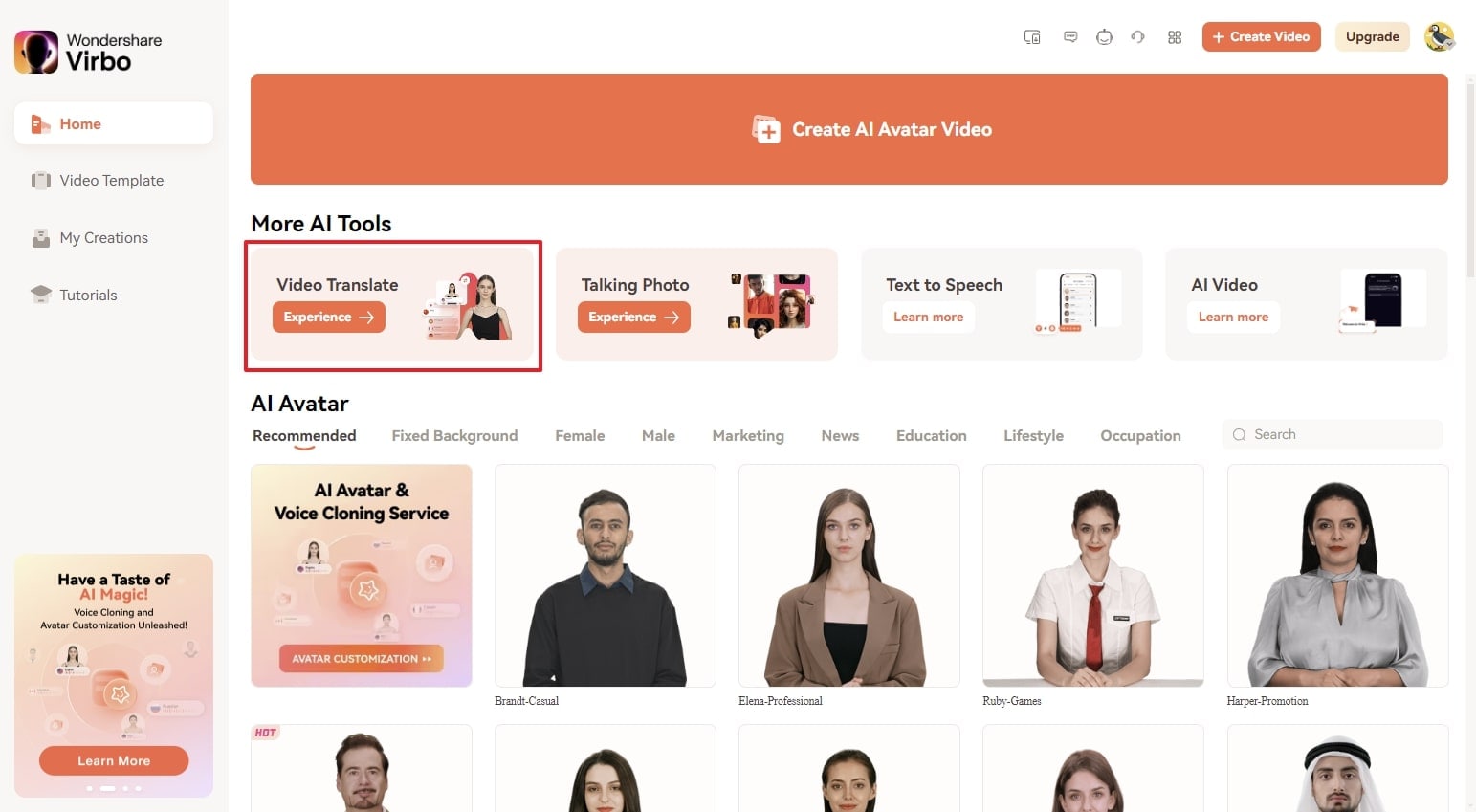
Choose Video Translator
Step 2. Perform the Video Translation
- To upload the video file for translation, press the “Click to upload video“ button, or you can use the drag-and-drop feature.
- Specify the “Original Video Language” and the “Target Language” and enable the required “Advanced Settings,” which are Lip-Sync, Subtitles, and Proofread Video Script.
- Finally, click the “Translate this video” button to change your video voice in the target language.
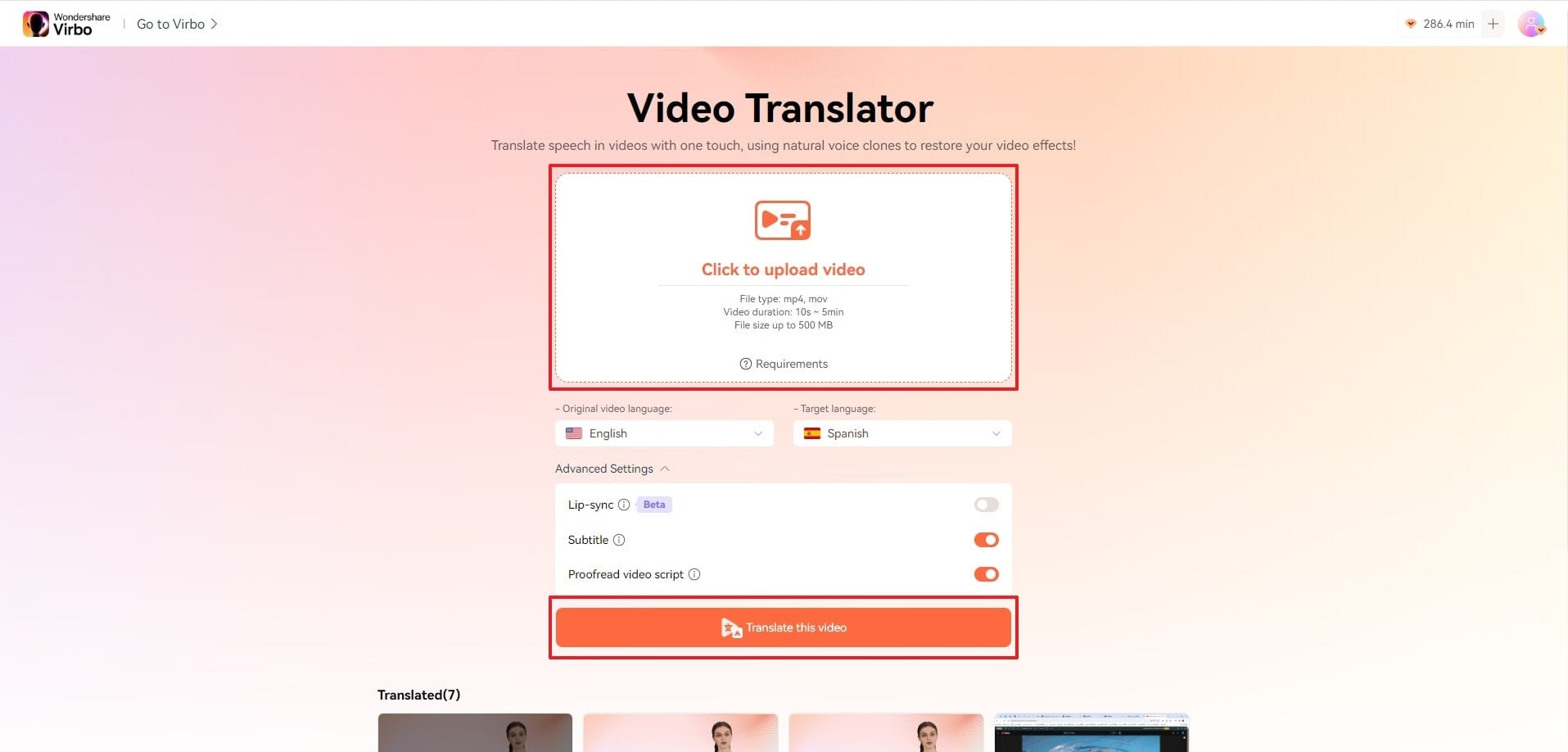
Perform Video Translation
Step 3. Proofread the Video Script
Proofread the translated video script to avoid any mistakes in the video. You can also export the subtitles file by tapping the “Download SRT” button. And then, click “Translate Video“
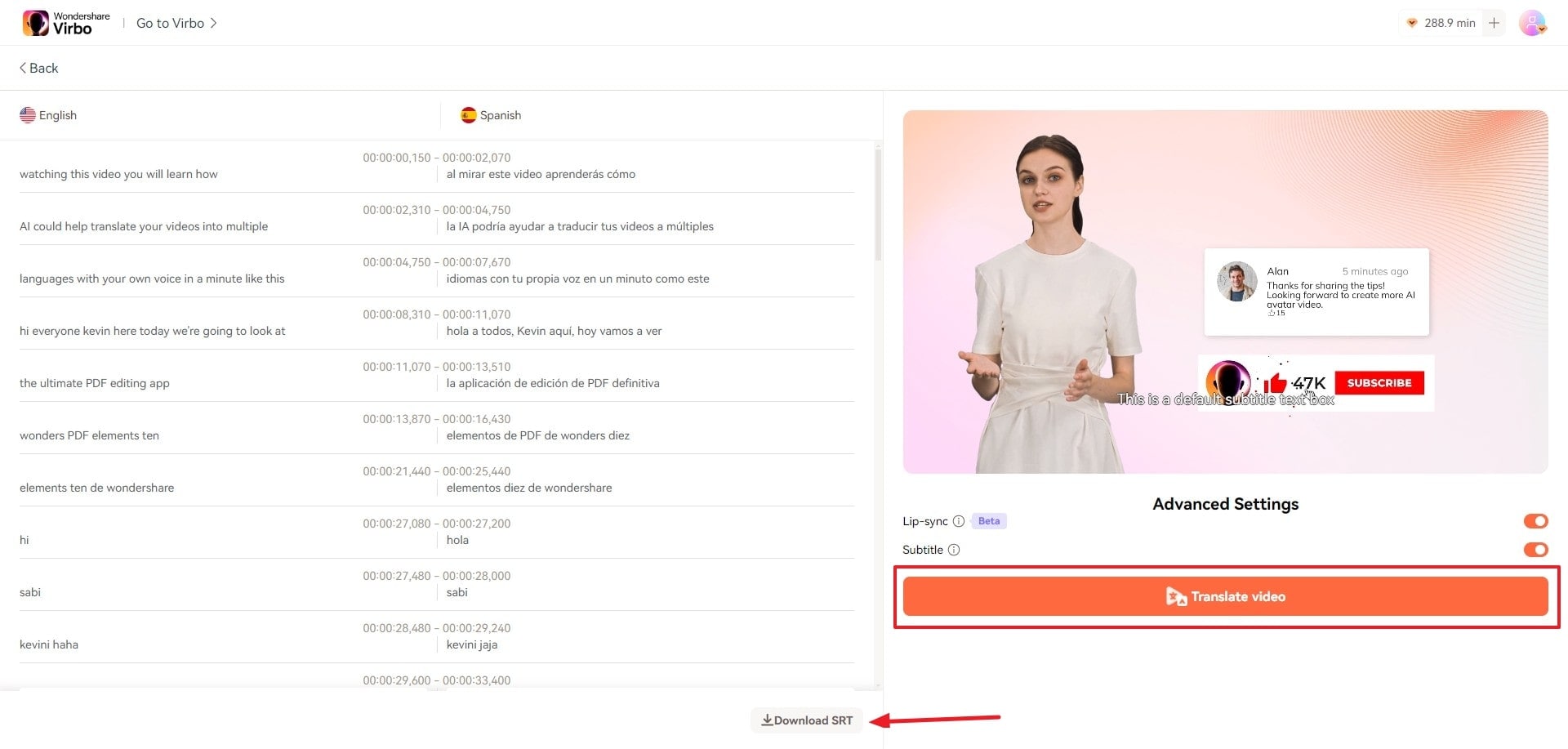
Proofread Script
Step 4. Proofread the Video Script
Preview the final version of the translated video and press the “Download Video” button to get it exported to your device.
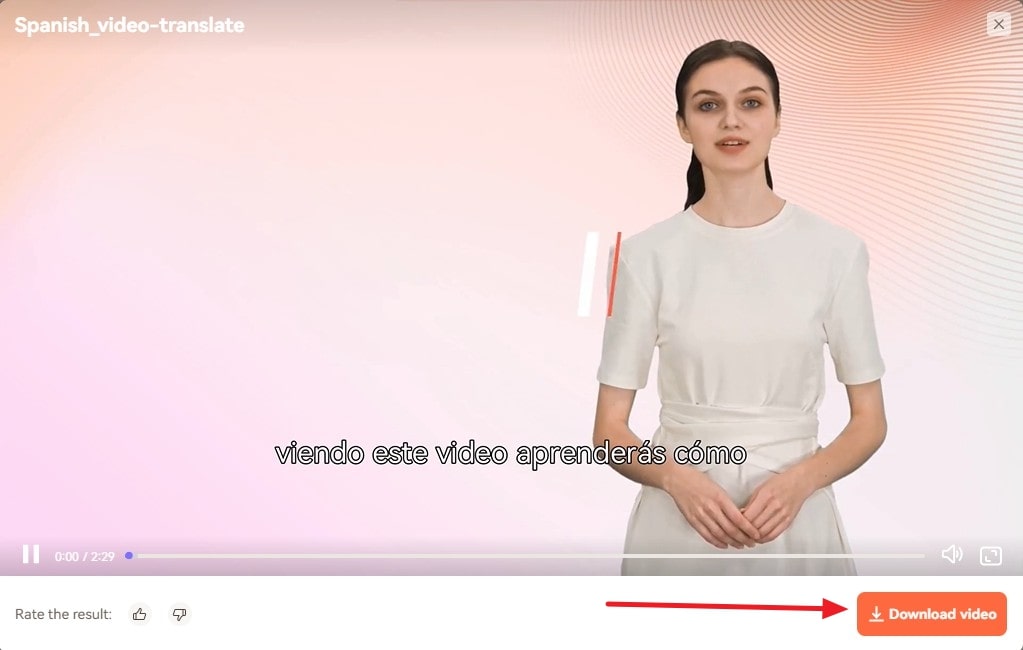
Download Video
FAQs about Video Translator
1Can I edit and export auto-generated subtitles?
Of course! You have the flexibility to modify and customize the generated subtitles to suit your preferences, and once done, you can seamlessly export the edited subtitle file.
2Is there a fee for using the Video Translator feature?
The Video Translator feature follows the Virbo subscription plan. This means that unsubscribed users can export a multilingual video of up to 2 minutes for free within 512MB storage space. For more information, please refer to the Virbo Subscription Plan>
3How accurate is the translation output?
The translation accuracy delivered by the Video Translator feature is remarkably high, thanks to the empowering capabilities of AI technology. The system utilizes advanced algorithms and machine learning to ensure precise and contextually relevant translations, enhancing the overall quality of the translated content.
02 Perform the Video Translation
04 Download the Translated Video
Step 1. Choose the Video Translate Feature
From the dashboard of Wondershare Virbo Online , choose the “Video Translator” feature under the “More AI Tools” section.

Choose Video Translator
Step 2. Perform the Video Translation
- To upload the video file for translation, press the “Click to upload video“ button, or you can use the drag-and-drop feature.
- Specify the “Original Video Language” and the “Target Language” and enable the required “Advanced Settings,” which are Lip-Sync, Subtitles, and Proofread Video Script.
- Finally, click the “Translate this video” button to change your video voice in the target language.

Perform Video Translation
Step 3. Proofread the Video Script
Proofread the translated video script to avoid any mistakes in the video. You can also export the subtitles file by tapping the “Download SRT” button. And then, click “Translate Video“

Proofread Script
Step 4. Proofread the Video Script
Preview the final version of the translated video and press the “Download Video” button to get it exported to your device.

Download Video
FAQs about Video Translator
1Can I edit and export auto-generated subtitles?
Of course! You have the flexibility to modify and customize the generated subtitles to suit your preferences, and once done, you can seamlessly export the edited subtitle file.
2Is there a fee for using the Video Translator feature?
The Video Translator feature follows the Virbo subscription plan. This means that unsubscribed users can export a multilingual video of up to 2 minutes for free within 512MB storage space. For more information, please refer to the Virbo Subscription Plan>
3How accurate is the translation output?
The translation accuracy delivered by the Video Translator feature is remarkably high, thanks to the empowering capabilities of AI technology. The system utilizes advanced algorithms and machine learning to ensure precise and contextually relevant translations, enhancing the overall quality of the translated content.
What Is an AI Tool?
Part 1: What is an AI Tool?
An AI tool refers to software or systems that leverage artificial intelligence algorithms and techniques to perform specific tasks or address complex problems. These tools aim to replicate human intelligence by analyzing vast amounts of data, identifying patterns, and generating predictions or recommendations.
Part 2: How does an AI Tool Work?
AI tools operate by utilizing various techniques such as machine learning, deep learning, natural language processing, and computer vision. They are trained on extensive datasets to learn patterns and make accurate predictions or classifications. Through algorithms, AI tools process and analyze data, identify trends, and generate valuable insights. Depending on the task at hand, AI tools can be trained to recognize images, comprehend speech, translate languages, detect anomalies, or automate repetitive tasks.
Part 3: What are the Widely Used AI Video Tools?
Several AI video tools have gained significant popularity across industries. Here are some widely used ones:
Video Analytics Platforms
These platforms, such as IBM Watson Media and NVIDIA Metropolis, employ AI algorithms to analyze video content. They can detect objects, recognize faces, track movements, and extract valuable information from video footage.
Video Editing and Enhancement Tools
AI-powered video editing tools like Adobe Premiere Pro, Virbo and Final Cut Pro X utilize machine learning algorithms to automate video editing tasks. They can enhance video quality, remove unwanted elements, and apply visual effects more efficiently.
Video Recommendation Systems
Platforms like YouTube and Netflix leverage AI to provide personalized video recommendations to users. These systems analyze user preferences, viewing history, and other factors to suggest relevant videos, enhancing the user experience.
Video Content Moderation Tools
AI tools such as Google Cloud Video Intelligence and Microsoft Azure Video Indexer assist in content moderation by automatically identifying and flagging inappropriate or offensive content in videos.
Part 4: What do we Need to Consider While Using AI Tools?
While utilizing AI tools, several factors should be taken into consideration:
Data Quality
AI tools heavily rely on high-quality and relevant data for training and accurate predictions. Ensuring the data used is clean, unbiased, and representative is crucial for the effectiveness of AI applications.
Ethical Considerations
AI tools should be developed and used ethically, considering factors such as privacy, fairness, and transparency. It is essential to avoid biases and ensure that the AI system does not discriminate against any individual or group.
Integration and Scalability
AI tools should seamlessly integrate with existing systems and have the capability to scale with increasing data volumes. Compatibility with other tools and frameworks is vital for smooth integration and efficient workflow.
Continuous Monitoring and Improvement
AI tools require regular monitoring and improvement to maintain accuracy and effectiveness. Regular updates and retraining of models may be necessary to adapt to evolving data patterns and enhance performance.
Conclusion
AI tools are software or systems that leverage artificial intelligence techniques to perform tasks and address complex problems. They find applications in various industries and can significantly enhance decision-making processes. However, careful consideration of data quality, ethical considerations, integration capabilities, and continuous monitoring is essential while utilizing AI tools in order to maximize their benefits.
Part 1: What is an AI Tool?
An AI tool refers to software or systems that leverage artificial intelligence algorithms and techniques to perform specific tasks or address complex problems. These tools aim to replicate human intelligence by analyzing vast amounts of data, identifying patterns, and generating predictions or recommendations.
Part 2: How does an AI Tool Work?
AI tools operate by utilizing various techniques such as machine learning, deep learning, natural language processing, and computer vision. They are trained on extensive datasets to learn patterns and make accurate predictions or classifications. Through algorithms, AI tools process and analyze data, identify trends, and generate valuable insights. Depending on the task at hand, AI tools can be trained to recognize images, comprehend speech, translate languages, detect anomalies, or automate repetitive tasks.
Part 3: What are the Widely Used AI Video Tools?
Several AI video tools have gained significant popularity across industries. Here are some widely used ones:
Video Analytics Platforms
These platforms, such as IBM Watson Media and NVIDIA Metropolis, employ AI algorithms to analyze video content. They can detect objects, recognize faces, track movements, and extract valuable information from video footage.
Video Editing and Enhancement Tools
AI-powered video editing tools like Adobe Premiere Pro, Virbo and Final Cut Pro X utilize machine learning algorithms to automate video editing tasks. They can enhance video quality, remove unwanted elements, and apply visual effects more efficiently.
Video Recommendation Systems
Platforms like YouTube and Netflix leverage AI to provide personalized video recommendations to users. These systems analyze user preferences, viewing history, and other factors to suggest relevant videos, enhancing the user experience.
Video Content Moderation Tools
AI tools such as Google Cloud Video Intelligence and Microsoft Azure Video Indexer assist in content moderation by automatically identifying and flagging inappropriate or offensive content in videos.
Part 4: What do we Need to Consider While Using AI Tools?
While utilizing AI tools, several factors should be taken into consideration:
Data Quality
AI tools heavily rely on high-quality and relevant data for training and accurate predictions. Ensuring the data used is clean, unbiased, and representative is crucial for the effectiveness of AI applications.
Ethical Considerations
AI tools should be developed and used ethically, considering factors such as privacy, fairness, and transparency. It is essential to avoid biases and ensure that the AI system does not discriminate against any individual or group.
Integration and Scalability
AI tools should seamlessly integrate with existing systems and have the capability to scale with increasing data volumes. Compatibility with other tools and frameworks is vital for smooth integration and efficient workflow.
Continuous Monitoring and Improvement
AI tools require regular monitoring and improvement to maintain accuracy and effectiveness. Regular updates and retraining of models may be necessary to adapt to evolving data patterns and enhance performance.
Conclusion
AI tools are software or systems that leverage artificial intelligence techniques to perform tasks and address complex problems. They find applications in various industries and can significantly enhance decision-making processes. However, careful consideration of data quality, ethical considerations, integration capabilities, and continuous monitoring is essential while utilizing AI tools in order to maximize their benefits.
[User’s Guide] How To Create Photo Talking Videos With the Best Tools?
Pictures and videos are crucial for preserving memories; companies also use them for promotional purposes. However, technology has now created an innovative and engaging way to use pictures. For example, you can now put life into your photos and make them a talking video.
If you are wonderinghow to make a photo-talking video , this article presents a complete guide. We will share some of the best tools for creating photo-talking videos. Simply follow it to the end to learn about it in detail.
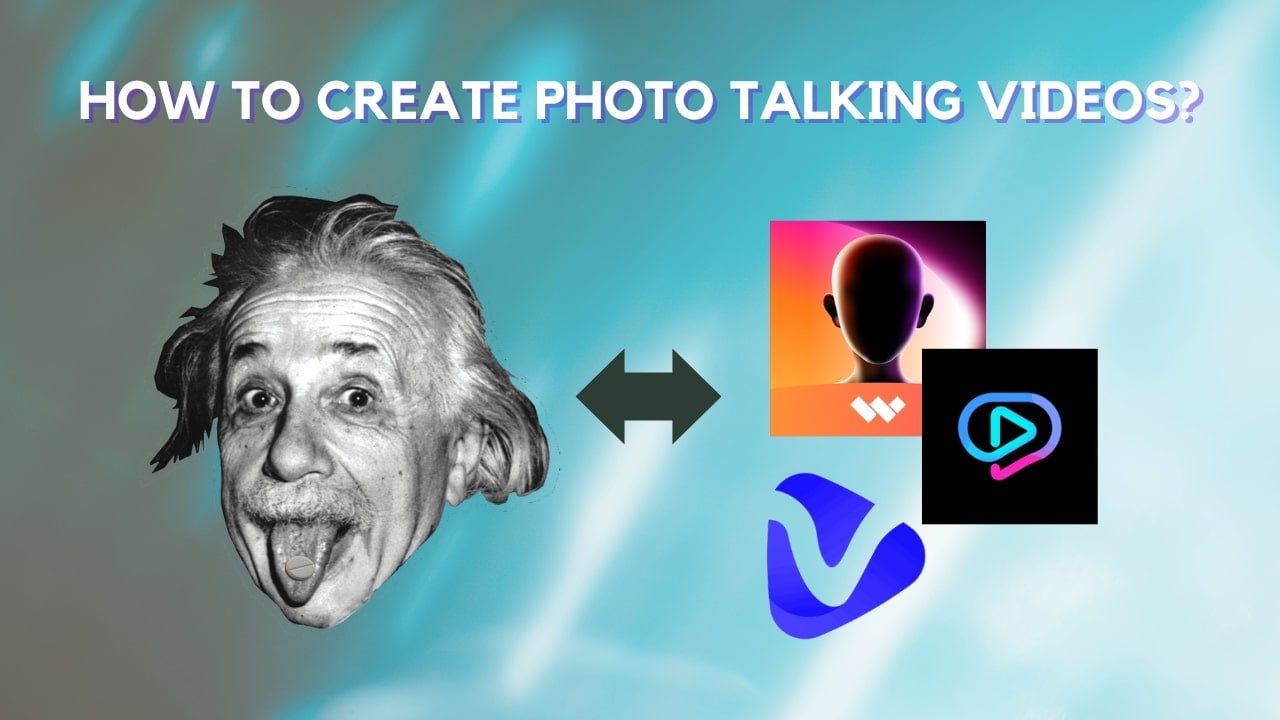
Part 1. What Is a Photo Talking Video?
Atalking-photo video is like a magic trick for making pictures engaging. You can take still pictures and make them move or talk like they are alive. It represents a captivating merge of photography and animation for an interactive experience. Moreover, new and creative ideas are always invented to make photo-talking videos even better.
No doubt this creativity takes your entertainment to the next level, but there’s more to it. These photos also change how companies talk to us about their products. It is like giving a voice to photos and using them to tell stories in a way that grabs customers’ attention. That’s why photo-talking videos are becoming a big deal in today’s market dynamics.
Innovations in Picture-to-Talking Video
People use various tools and techniques to convert images to talking videos. These techniques may include mobile applications or computer software, which keep getting innovations:
- Integration of artificial intelligence for more realistic movements.
- Use of facial recognition technology for accurate lip-syncing.
- Implementation of voice synthesis to generate lifelike speech.
- Introduction of interactive features allowing user engagement.
Part 2. How To Create Talking Video With Reliable Desktop Tool—Wondershare Virbo
In the above sections, we have introduced the concept and importance oftalking photo videos . Let’s head to the part where you will know how you can create them with tools. One of the most straightforward methods to generate such talking photos is Wondershare Virbo . Whether you want to market a product or deliver a presentation, using this tool is a good idea.
With its AI-powered Talking Photo feature, you can bring life to your pictures. Not only can you make them move, but you can also add voice clips for a better and more engaging experience. You can count on this diversified tool with variating compatibility for integrating your pics with social media platforms. It even allows users to create such content online and offline.
Top-Rated Features of Wondershare Virbo
- Wondershare Virbo can convert the text you provided to speech for use in your talking photos.
- You can customize your uploaded voice in talking pictures to make it more interesting.
- Using the versatile AI avatars of this tool, you can attract and engage a broader audience.
- This tool allows users to add background music to their content for personalization.
Step-by-Step Guideline To Create Talking Photo Videos Using Virbo
Wondershare Virbo provides a smooth and simple process for creating such art. This section will explain how to make a photo-talking video with the help of this tool:
Step 1. Initiate the Creation Process With Virbo
First, download and launch the Wondershare Virbo application on your system. From its main interface, tap the “Talking Photo” feature from its home screen.
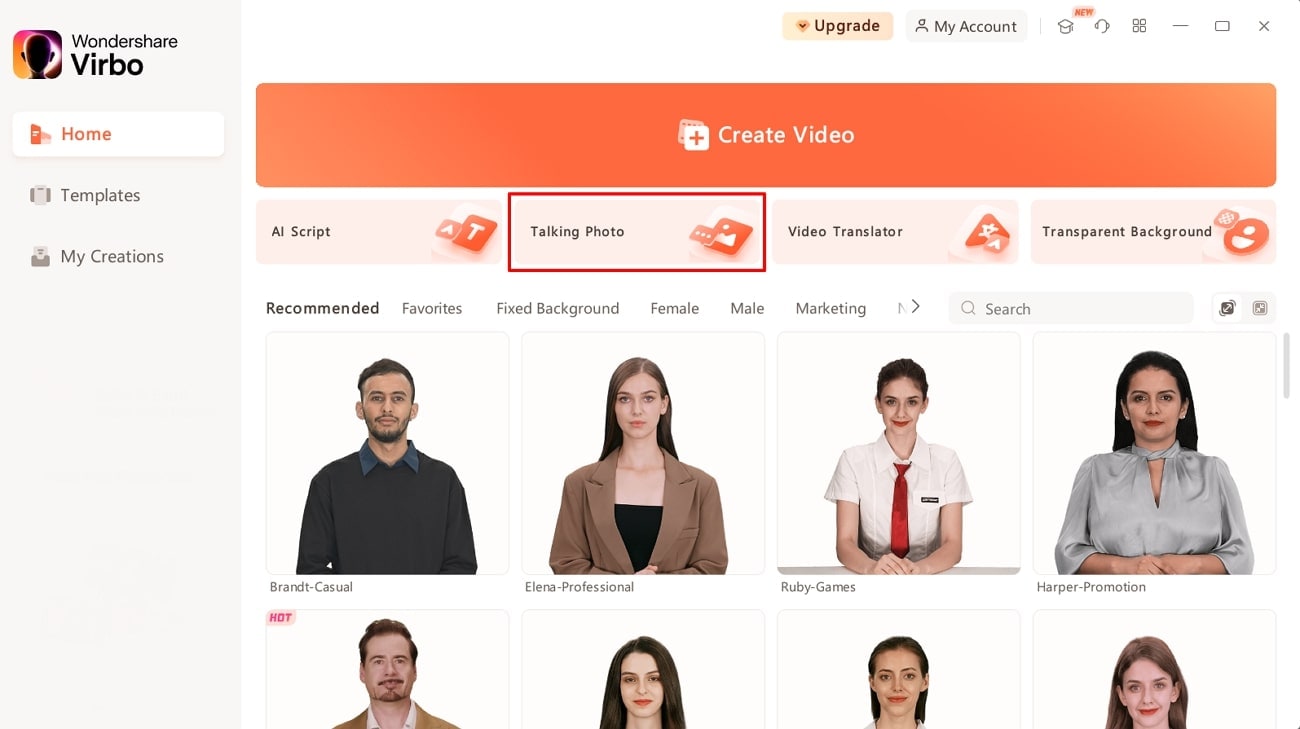
Get Started Online Free Download
Step 2. Choose an Image To Create Talking-Photo Video
You will access a new pop-up window with different preset image avatars by clicking on this feature. Select your desired avatar and click the “Create Video” button to initiate the process.
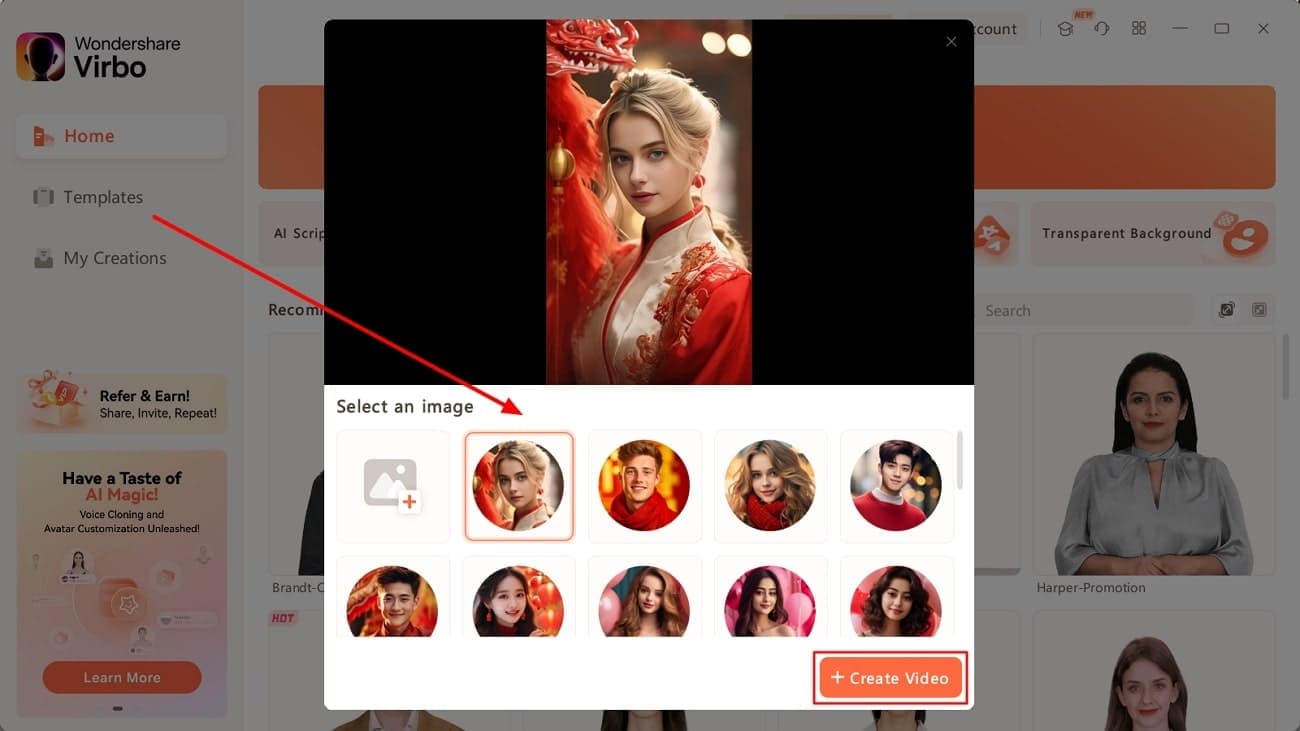
Step 3. Input the Text or Recorded Audio for AI Speech
Enter the text you want to use in your talking photo. You also have the option to shift to the “Audio Script” tab to upload your audio to convert your picture to a talking video.
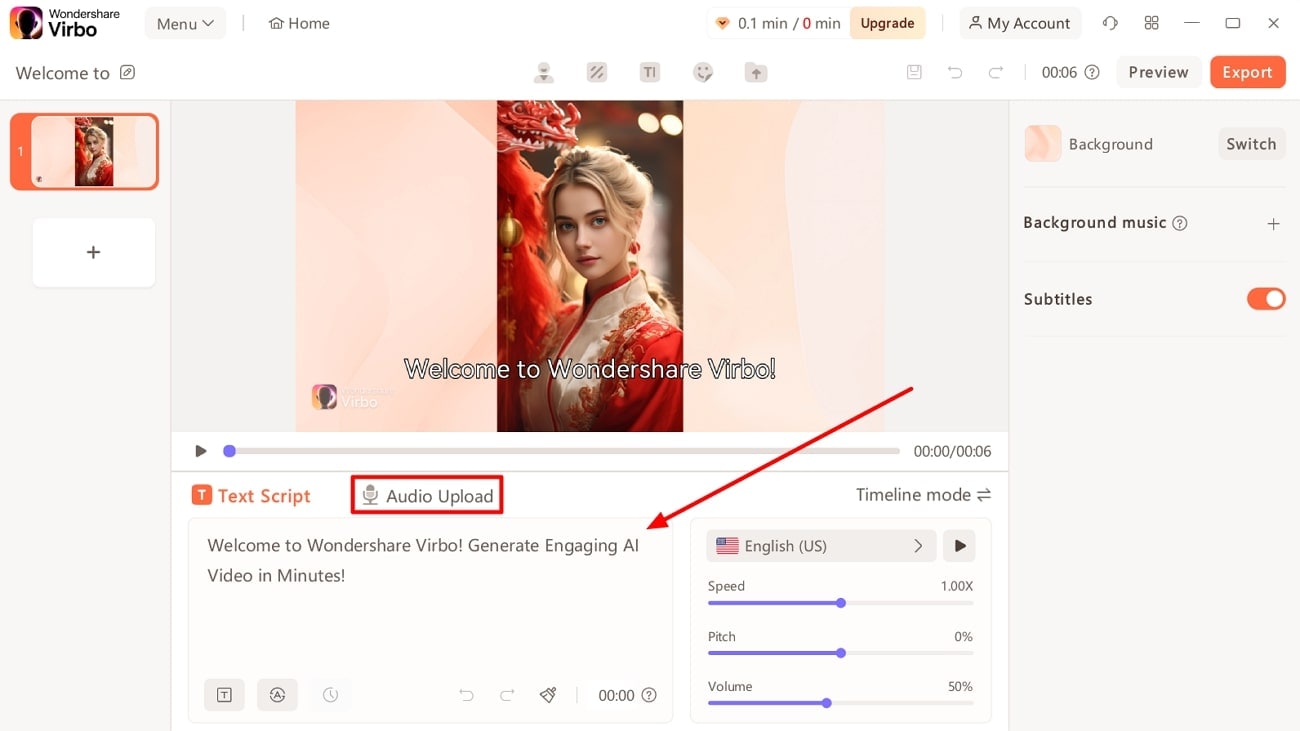
Step 4. Select the Language and Accent for Your Video
After that, scroll to the “Language” portion and click on it. A new pop-up window will appear where you can choose any language and accent. Hit the “Gender” dropdown menu to select your desired gender, and finally, tap the “OK” button.
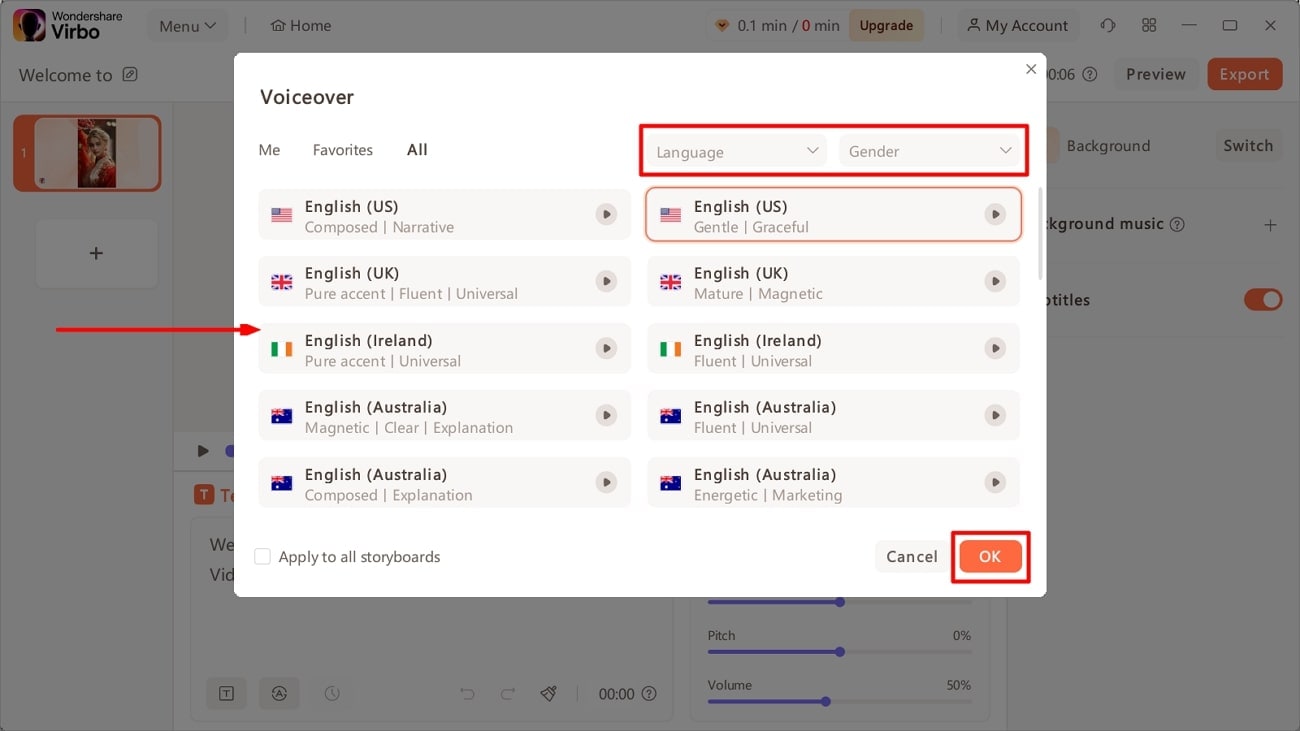
Step 5. Customize Voice Features and Export Talking Photo
Now, set the speed of delivery voice as per your requirement. You can also customize the volume and pitch of it. Finally, click the “Export” button in the upper right corner. After selecting the resolution for the output file, you will be redirected to the “My Creations” section with saved files.
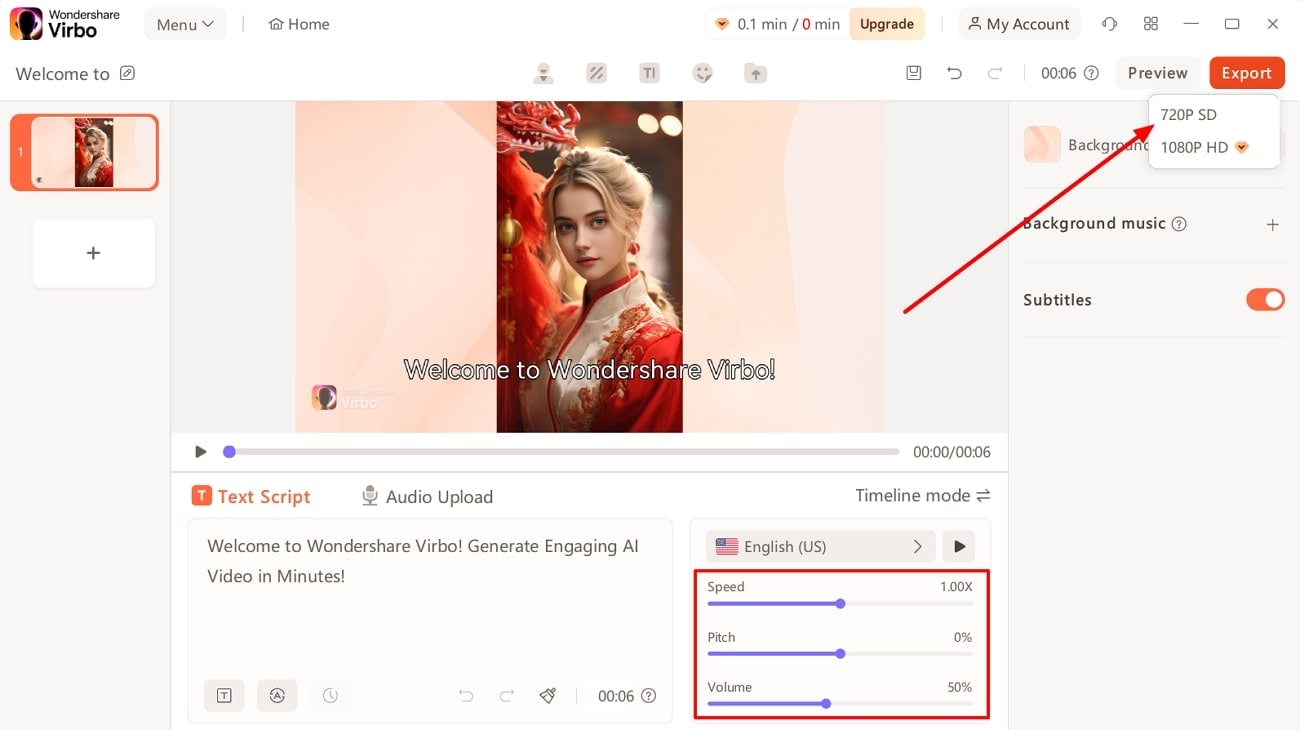
Part 3. How To Create Photo Talking Videos With Some Top Online Tools
Wondershare Virbo is the ultimate choice for making your photo into a talking video. However, we will mention alternative online tools if you are still looking for them. Go through this section to learnhow to make a talking picture video using the top online tools besides Virbo:
1. Vidnoz
Vidnoz is an online AI-powered tool that can create talking photos within minutes. It can convert your still picture into a realistic talking avatar that you can use for various purposes. You can also choose between built-in avatars for this creativity. Additionally, Vidnoz allows users to perform a face swap operation, where you can swap the face in a picture with any other face. If you intend to use this tool to convert images to talking videos, walk through these steps.
Step 1. First, access the official site of the Vidnoz tool and scroll to the “Free AI Tools” section. In the list of features, look for the “AI Talking Photo” feature from there to get started.
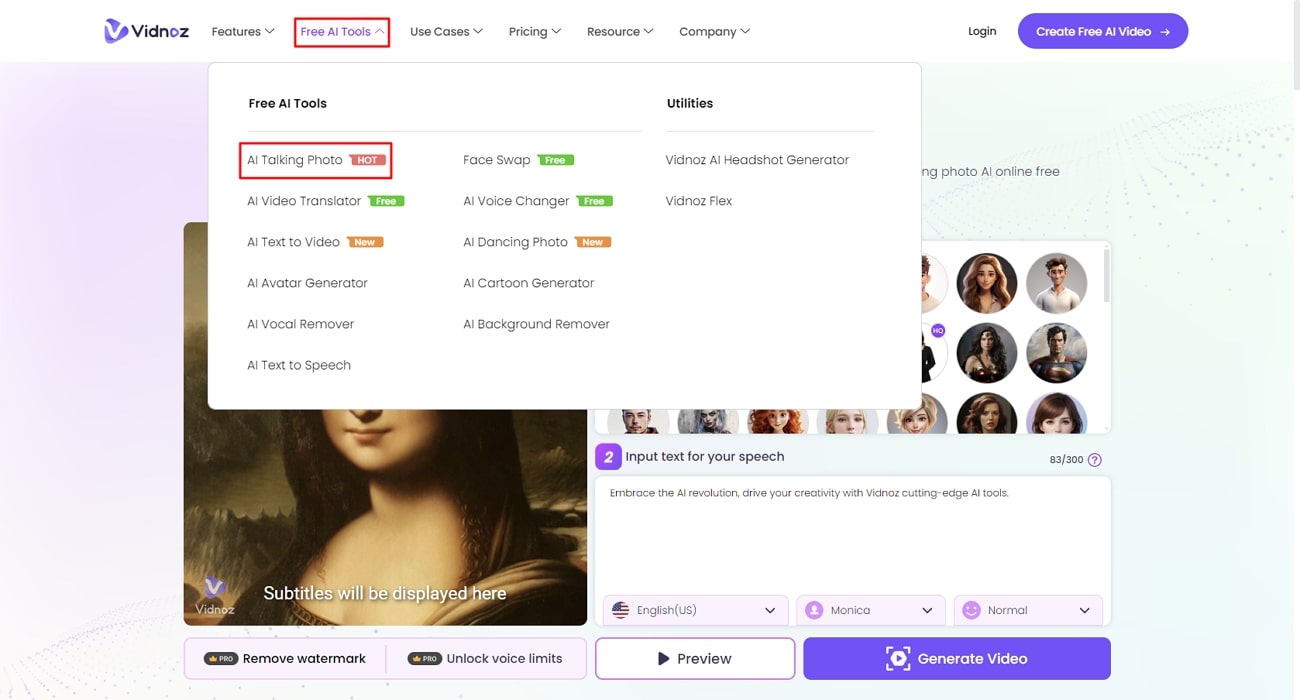
Step 2. After that, select the avatar from pre-available options. You can also upload your own desired picture for this purpose.
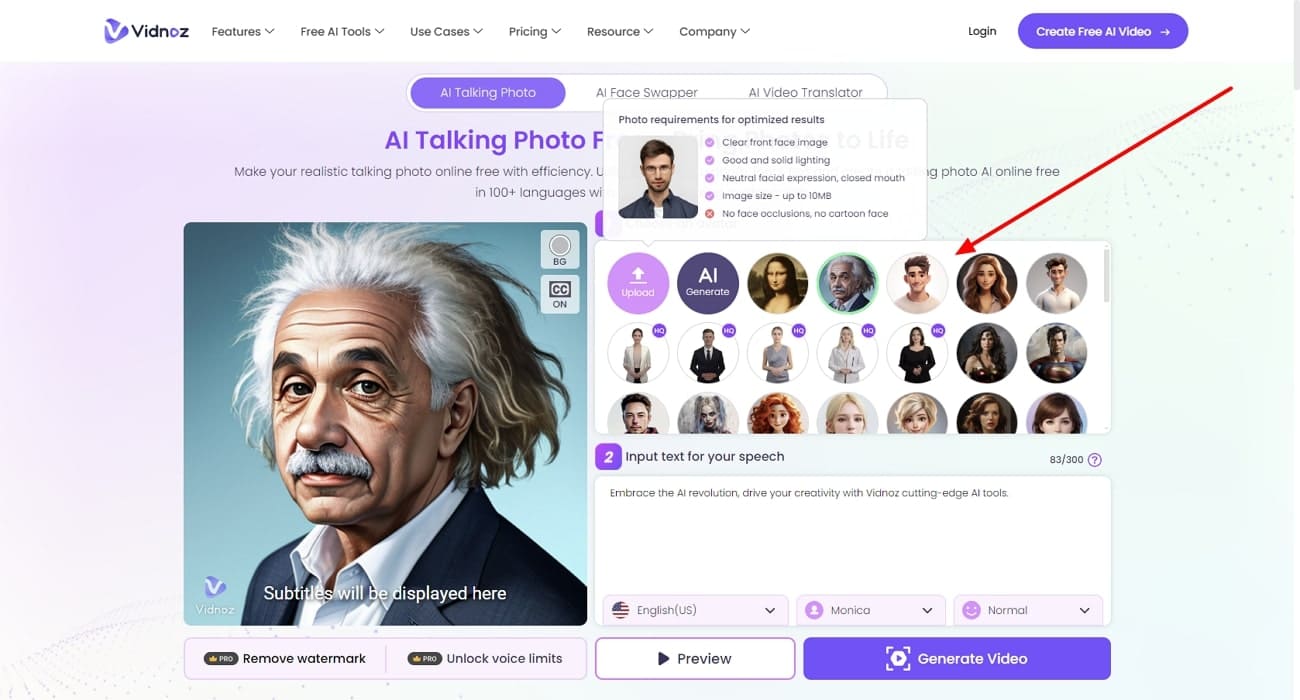
Step 3. Then, go to the text box section and input any text you want to convert to speech. Also, select any preferred language, voice, or mood from the below dropdown menus.

Step 4. Once everything is set, click on the “Generate Video” button to finalize the creation of a talking-photo video. A pop-up window then appears on the “My Creations” page. You can download it to your device or share it directly on social media platforms from that window.
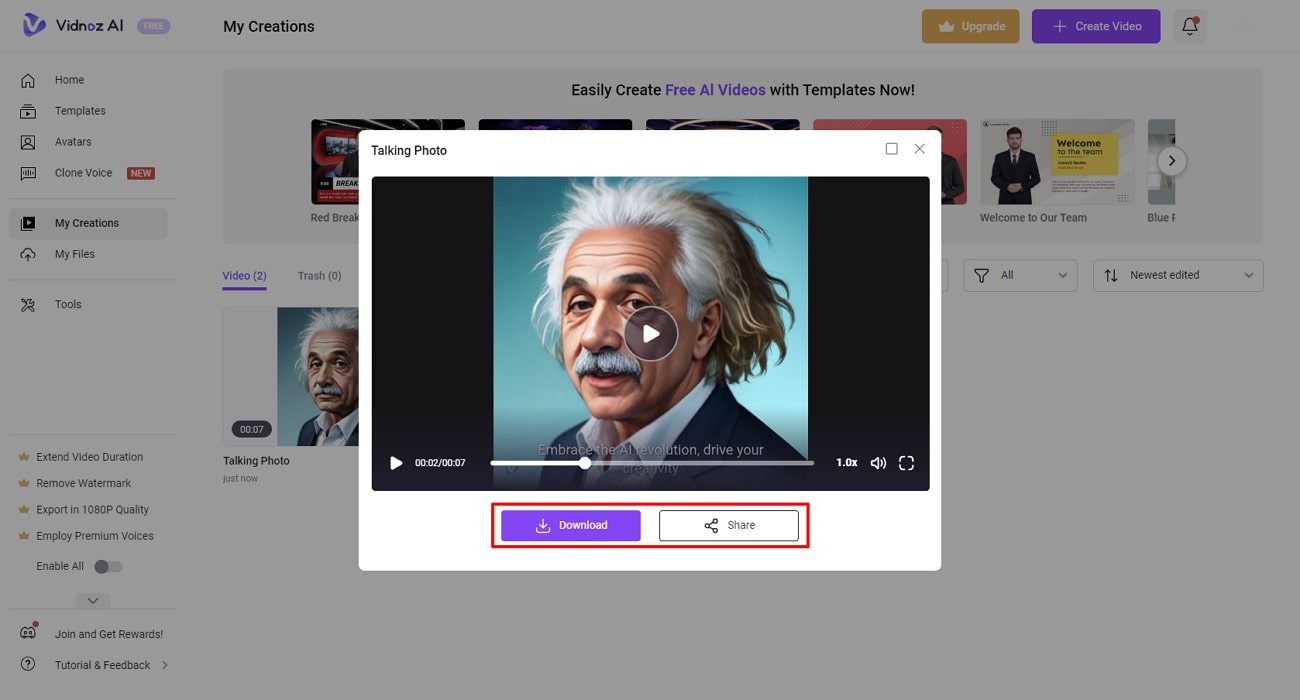
2. Feedeo
Feedeo is also an online talking photo creator that enables users to make interactive content. With its wide range of AI avatars and voices, you can have a customizable and versatile experience. In addition, you can also use your pic to showcase yourself in the talking photo. To convert your photo to a talking video with Feedeo, apply this guide below:
Step 1. Go to the Feedeo website and log in through your account. Once done, you will be shifted to the dashboard page. Then, select the “Templates” section from the left sidebar and choose any template you want.
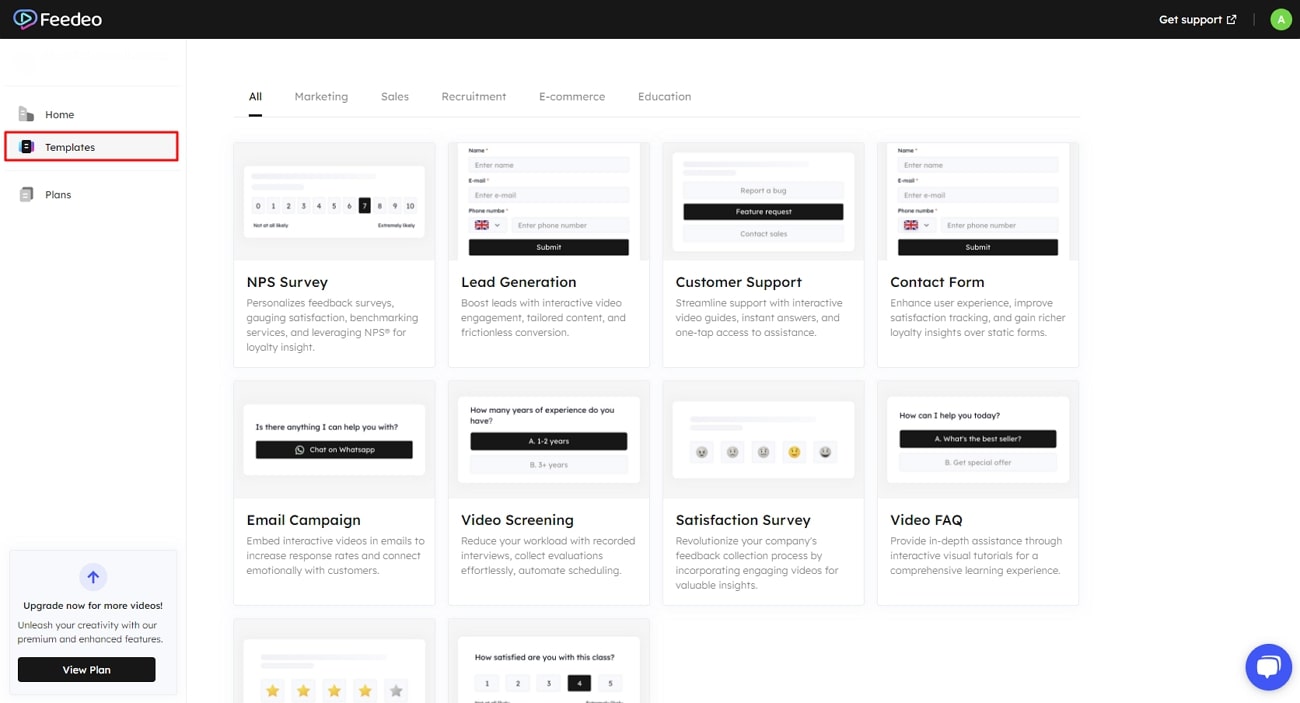
Step 2. After that, you will reach the editing interface of this tool. Select a virtual avatar you want to use for your talking photo or upload your photo.
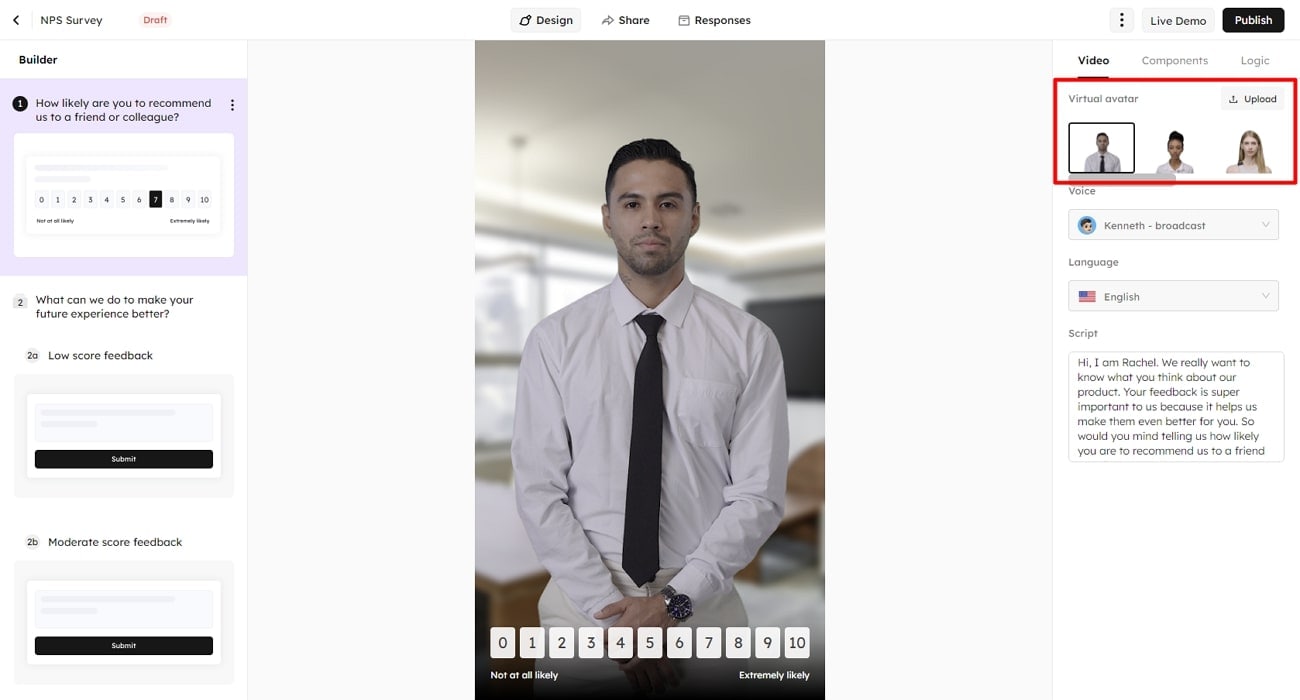
Step 3. Go to the “Voice” dropdown menu and choose any voice and its tone. Afterward, select your desired language from the “Language” dropdown menu. In the section below, you can type any text as the script of your talking photo.
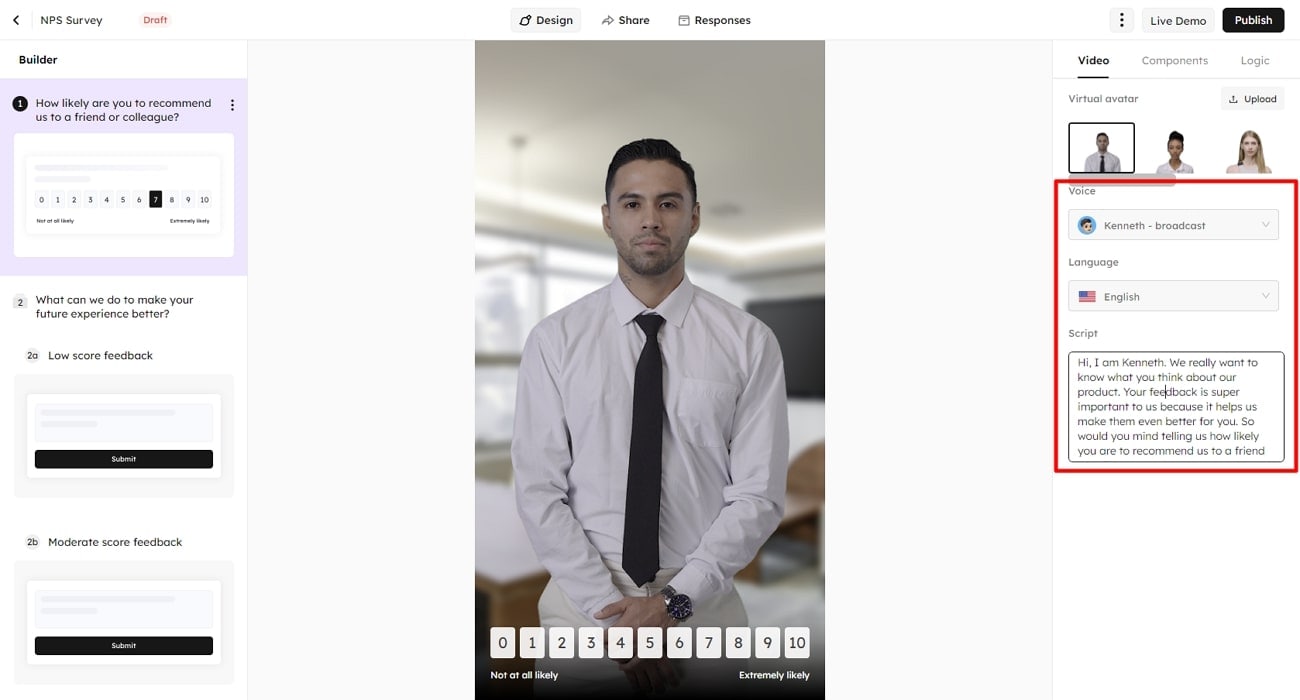
Step 4. Now, hit the “Publish” button, and it will start processing in a new pop-up window. A message will then appear for successful publishing, from where you can share the output file to multi-platforms.
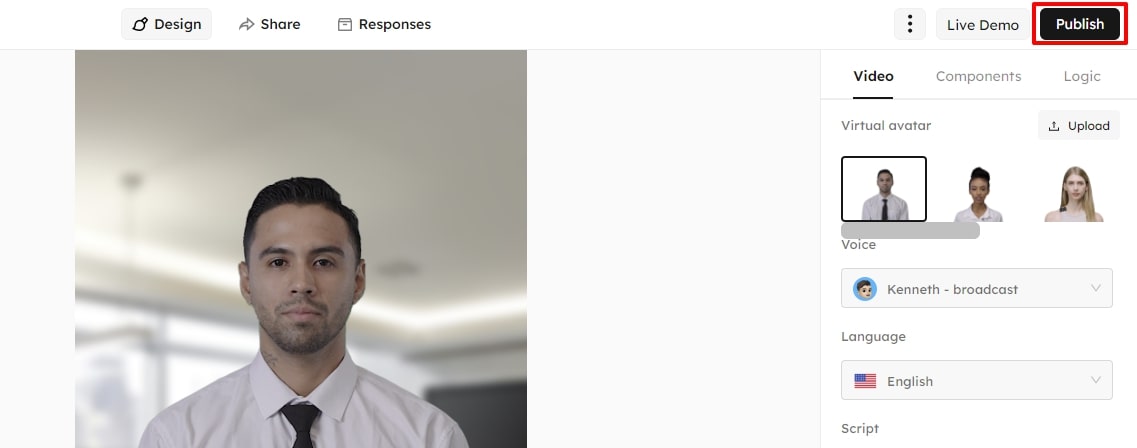
Conclusion
It is incredible how AI-powered tools can transformimages into talking video s. We have shared information on some of the best tools to create such art. However, if you are confused about choosing the best one, Wondershare Virbo is the clear choice. With multiple AI avatars and different language dialects, Wondershare Virbo can surely make your talking photos more fun.
Get Started Online Free Download
Register | Online
Register and Login to Wondershare Virbo
Effortlessly access the full potential of Wondershare Virbo by seamlessly registering and logging in, unlocking a world of creative possibilities for your video editing experience.
Register & Login
❶ Click to open Wondershare Virbo online .
❷ Navigate to the Login button at the upper right.
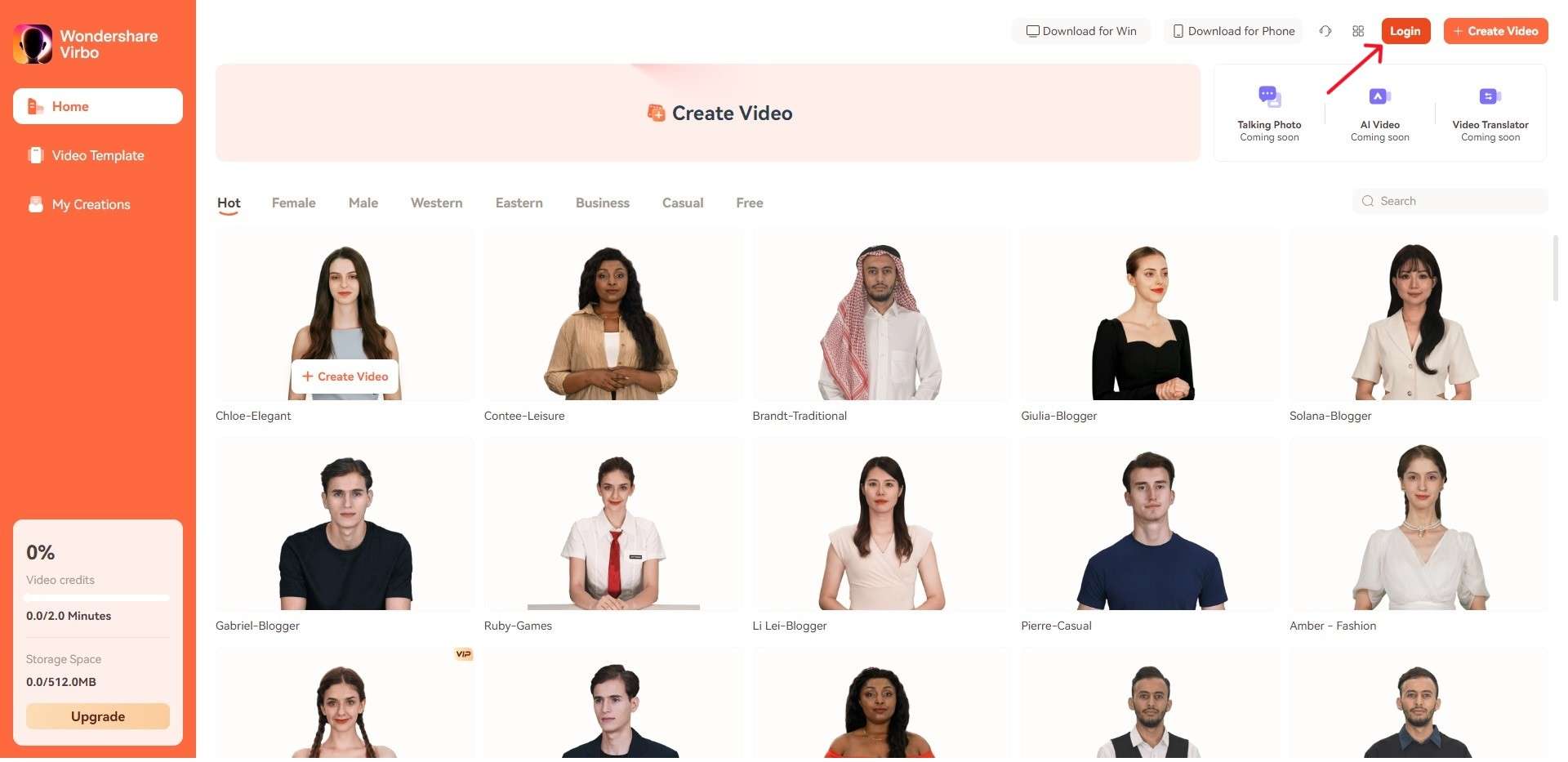
Login Virbo
❸ Log in with your Wondershare ID. You can also sign up and log in with your Google account.
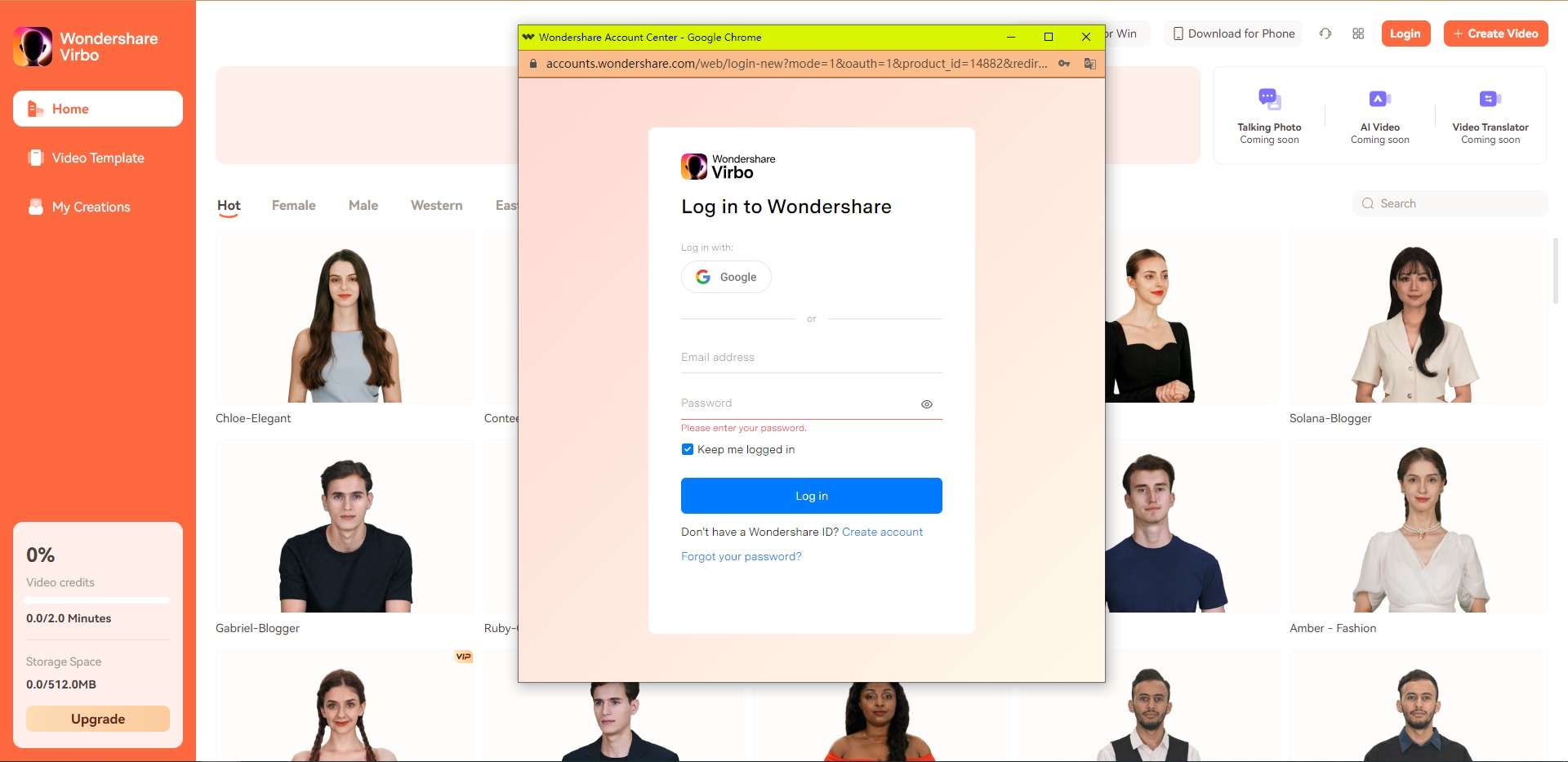
Log in with Wondershare ID
❹ After a successful login, click the Avatar icon to verify your activation status.

Check Your Activation Status
❸ Log in with your Wondershare ID. You can also sign up and log in with your Google account.

Log in with Wondershare ID
❹ After a successful login, click the Avatar icon to verify your activation status.

Check Your Activation Status
❸ Log in with your Wondershare ID. You can also sign up and log in with your Google account.

Log in with Wondershare ID
❹ After a successful login, click the Avatar icon to verify your activation status.

Check Your Activation Status
❸ Log in with your Wondershare ID. You can also sign up and log in with your Google account.

Log in with Wondershare ID
❹ After a successful login, click the Avatar icon to verify your activation status.

Check Your Activation Status
Best 10 Chinese Video to English Translators
There are more than 1.35 billion people speaking English, and the majority of them aren’t even native English speakers. However, with around 1.3 billion people speaking Chinese, the two are some of the biggest languages in the world. But what if you want to translate a Chinese video to English and vice versa?
We have got just the solution for you. In this blog, we are covering the best Chinese translation tools that you can use today to reach a global audience.
Part 1. Most Recommended Tool for Video in Chinese Translation - Virbo
To enhance your communication, Wondershare Virbo is the most recommended platform. It’s an AI-powered software that can craft engaging videos without a camera, actors, and resources. You can break the language barrier by creating multi-lingual versions of videos. Virbo also has an AI video translator that can translate Chinese video into English.
It uses AI voice cloning technology and generates localized content with audio-visual harmony. Users can translate videos of 10 seconds to 5 minutes with a maximum 500MB file size. Due to its versatile compatibility, it is available on online browsers and mobile and desktop applications.

Key Features of Virbo - Video Translation
- Lip-Sync: Virbo has a lip-sync option to obtain a perfect translation of explanatory videos. During video translation, you can enable it for harmonious synchronized expressions.
- Subtitles: Most individuals prefer to consume video content with subtitles. You can toggle to get subtitles when translating videos into other languages in Virbo.
- Proofread Video Scripts: Try this option if you are dealing with professional video in Chinese translation. It supports proofreading your original video script and the translated script before submission. This way, it ensures consistency and accuracy in translated language.
- Diverse Language Support: Virbo translation feature offers diverse language support to expand your content reach in every region. In that context, it can translate your videos into more than 20 native or regional languages. Some of its popular languages include Spanish, Arabic, Chinese, English, and Russian.
- Seamless Translation: You can easily add in your video that you want to be translated, and within a couple of moments, you will see your newly translated video.
Additional Features of Virbo
- AI Avatar: As briefly discussed above, using Virbo, you don’t need actors and a camera to create a Video. It has life-like AI avatars from diverse age ranges, ethnicities, regions, attire, and gender. Using more than 300 AI avatars, you can craft educational videos, advertisements, Promos, etc.
- AI Script Generator: Are you having a tight deadline for video production, but the script isn’t ready? This feature of Virbo can create compelling scripts tailored to your needs within seconds. You only need to enter keywords such as targeted audience, preferred language, brand name, etc.
- AI Talking Photos: This feature allows users to bring life to a static image. It lets you add a voice clip to your photo and turn it into a living narrative. You can explore Virbo’s AI talking photo library or upload your straight-looking image. You can upload audio or record online to add voice to the image.
Translate Video Now Download APP Now Free Download
Steps to Translate Video Chinese to English
- To translate video, the first step is to sign up on the official website of Virbo. Simply go to Virbo’s official website , select the “Login” button in the top right corner, and sign-up/sign-in according to your situation.

- Now, you will be redirected to Virbo’s tool page. You can also just download the tool in your Windows device for better user-experience. Once you’re on the main page, select “**Video Translator.**”

- Now, you will access the Video Translator tool with various options. Here, you will need to upload the Chinese video you want to translate, select “Chinese” in Original Video Language, and set the Target Language to “English.” Once the file is uploaded, select “Translate this video.”

- Now, you need to wait for the video to be translated. Once it’s finished, you can simply download it and have your Chinese video translated into English.
Translate Video Now Download APP Now Free Download
Why is Virbo the best Video Translator?
Virbo is one of the best video translators due to its versatility and use cases. It features a fast translation speed, easy-to-use user-interface, and most importantly, other video production features. You can translate a handful of languages like German, English, Chinese, Spanish, Japanese, and more.
However, in this blog, we are covering Chinese to English video translation. Virbo also allows you to create AI videos in most languages with varying ethnicities. So, if you’re looking for a translator that would be flexible and easy-to-use, Virbo will be your best choice.
Translate Video Now Download APP Now Free Download
Part 2. How to Evaluate the Quality of Translated Chinese Videos?
Generate Engaging
AI Video in Minutes!
Easily convert text into professional spokesperson videos in over 120+ voices & languages in minutes.
Generate AI Video Free Generate AI Video Now
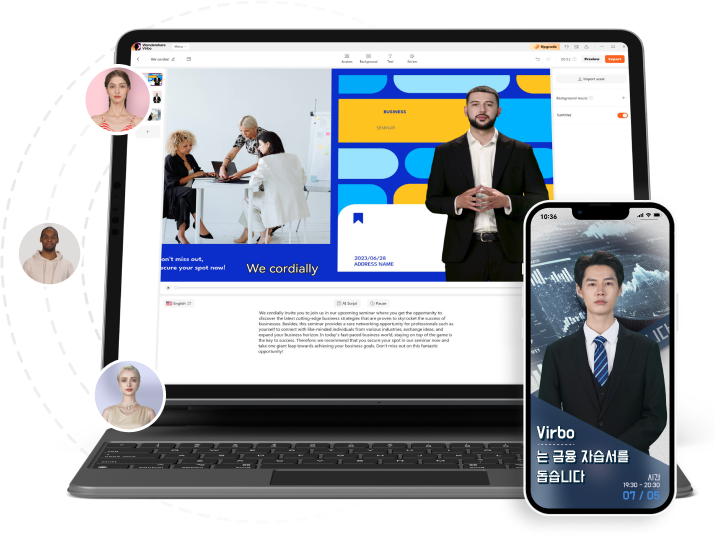
When it comes to evaluating the quality of a translated video, even if it’s other than Chinese, you need to keep one factor in mind. Accuracy is everything in translation. Thankfully, Virbo is known for its reliable and accurate translation results in all the languages it supports. An accurate translation ensures the message is true to the source text’s meaning and intent.
However, for complex language translations, even the greatest AI would suffer. This is because of complex grammar, idiomatic expressions, and specialized terminology. In those cases, you might need to edit some parts of the translation manually. Overall, accuracy is the landmark of quality in translated Chinese videos.
Part 3. Alternative 9 Methods to Translate Chinese Video to English
1. Speechify

Speechify is hailed as one of the best translators, as it supports over 80+ languages and can translate videos in a matter of minutes. The tool is used by many news networks and media companies like the Wall Street Journal, Forbes, CBS, and more.
What Speechify excels in is saving you a bunch of money since you don’t need to hire a translator. You can instantly make your videos reach a global audience. But aside from the translation tool, Speechify also contains many other AI tools that anyone can use to make complex tasks easier.
Here are some of its key features:
- 80+ languages support
- Full-featured AI suite for audio and video translation
- Realistic AI voices with native sounds
- Ideal for documentaries, training, and marketing videos
2. Smartcat

Smartcat is a translator that lets you translate from video Chinese to English . Their portfolio includes brands like eBay, VOLVO, Trip.com, and other high-profile companies that build up their credibility and make Smartcat a very heavy contender on this list.
But how good is it actually? Well, Smartcat is all about speed and efficiency, and that’s why it is known to improve your translation workflow by more than 70%. The tool is fairly easy to use. All you need is to upload your Chinese video file and select English, and within a couple of minutes, you will get your translated video.
Here are some of Smartcat’s key features:
- Simple and fast translation of any file format
- Hire actual translators to review the file
- Plethora of subtitle translation features are available.
3. HitPaw

In the world of Chinese video translators, HitPaw is one of the fastest. It uses ChatGPT to translate into multiple languages. But what’s more interesting is that the tool also has many other features like an AI voice clone, lip sync, voice changer, and a lot more.
HitPaw is one of the best tools for translating social media videos as well. It provides high-quality results with great accuracy, and that’s why it has become one of the most popular tools in the content creation world.
Here are some of its key features:
- Translate YouTube videos for different countries
- Supports voice changer, AI video generator, auto subtitle generator, and more
- Supports text-to-speech and speech-to-text feature
4. Auris AI

Auris AI is one of the best tools for video in Chinese translation. It supports all Asian languages and translates videos instantly with its advanced AI. With Auris, your business can reach a wider audience so you can gain more subscribers, reach more people, and make global connections.
Moreover, you can also improve SEO if you’re a marketer, which means that targeting a specific group of audience would be a piece of care for you. Here are some of Auris’ key features:
- Supports all Asian languages
- Powered by AI and assisted by language professionals
- Four-step easy Chinese to English translation
5. Keevi

Keevi is another Chinese video to English translators and it works with many other languages. However, the only thing to keep in consideration is that all of your videos will be transcribed by the tool first and then translated into English.
This takes some extra time but is ultimately a great way to get translated videos. Thankfully, everything is included in Keevi, meaning that once you upload a video, you will get your translated video in little to no time.
Here are some of its features:
- Video editing features available
- Multiple ways of translation
- Get an edge over your competitors by targeting a global audience
6. Tomedes

A great method to translate Chinese videos to English is a translation service. While there are many tools, if you don’t have the budget to hire a full-time translator but also want some video translated, then a marketplace for translation would be ideal for you.
Tomedes is a service used by companies like Amazon, Google, Wix, Bloomberg, and more. The translated service provides a 1-year guarantee, meaning that you are basically going to get some of the most highly professional individuals translating the videos for you.
Here are some of its key features:
- Available online 24/7
- 1-year guarantee
- 95,000 business customers
7. ZeemoAI

ZeemoAI is an all-in-one package for influencers, individuals, companies, and enterprises to handle their media side of things. It features many tools like auto subtitles, transcription, and a caption generator.
However, when we talk about Zeemo’s AI video translation tool, it is in a league of its own.
Here are some of its key features:
- Easy three-step video translation
- Engage with subtitles with over 500+ templates
- Bilingual subtitles support
8. EasySub

EasySub , as the name suggests, easily translates videos in over 150+ languages. With a simple registration process and free initial projects, it is a fairly simple software that allows you to translate Chinese into English. It is also one of the few software that has a 98% accuracy rate, which is impressive.
It also offers some other features, like being able to download the translated text and edit it according to your liking. Here are some of its key features:
- Ideal for TikTokers, Students, Teachers, Professionals
- Allows downloading of subtitles for further editing
- Has the most accurate translations, with an accuracy rate of 98%
9. Sonix AI

But what if you want to simply grab the text from a Chinese video and convert it into English? For that, we have Sonix AI—one of the simplest and fastest tools on the market. Sonix AI gives you a free trial to translate up to 30 minutes of video with free translation and free transcription.
You can also polish your final transcript and change anything that might look like an error to you. Here are some of the key features of Sonix AI:
- Free trial comes with a lot of benefits
- Fast and effective speech-to-text algorithm
- Affordable price
FAQs
- What is the right way to translate a Chinese video on YouTube?
If you want to translate a Chinese YouTube video, you can use Wondershare Virbo. Its AI video translator will assist you where you need to add Chinese as the original video language. Later, choose the targeted language and let AI work on your prompts.
- What is the processing time for translating Chinese video content into English?
While using Virbo for video translation, you don’t need to wait long for processing. It usually takes a maximum of 2 minutes to translate a 1-minute video. Meanwhile, processing duration also depends on your content.
- Is it easy to translate and dub Chinese videos into English?
Yes, translating a Chinese video into English using Virbo is exceptionally easy. All you need is to upload your video, choose languages, adjust some more settings, and you are good to go.
- Does it cost a fortune to translate and dub Chinese videos into English?
Usually, AI-powered video translators are costly depending on video length and content. However, Virbo is a free-to-use platform for beginners. To use its premium features, you need to subscribe to its cost-effective plans.
- What is the efficient technique for adding translated subtitles to videos?
The best way to add translated video subtitles remains Wondershare Virbo. Apart from translating videos, it can add translated subtitles to the video in seconds within the feature.
Translate Video Now Download APP Now Free Download
Final Verdict
With so many translation tools all over the globe. Which one suits you the best? Well, it depends on your individual needs and goals. But if you want a tool that is effective in Chinese to English video translation, then using Virbo will be a great way to get your business goals done.
It comes with other features like AI avatars, voice cloning, and transcription, which means that you can do beyond just video translation but video production as well.
Translate Video Now Download APP Now Free Download
Also read:
- [New] 2024 Approved A Visual Revolution How to Upgrade Your Snapchat Photos
- [New] Top 5 Mac Capture Programs Outperforming Bandicam for 2024
- [Updated] 20 Guidelines Livestream Webinars at No Extra Charge
- [Updated] Top-Rated Sony A7S II Memory Accessory
- 2024 Approved DirectSnapRecorder Straightforward Windows 11 Capture
- Easy Steps to Change QuickTime MOV Videos Into M4V on macOS & Windows Computers
- Handling Exceptions for 2024
- How to Fix Launch Errors for the Star Wars Jedi: Fallen Order Video Game
- In 2024, Best 4 Elon Musk Voice Generators to Make You Sound Like the Billionaire
- Master the Art of Fast Internet Sharing Using D-Link's Powerline Technology - Your Step by Step Guide
- New AI Translation | Online for 2024
- New In 2024, A Detailed Review & Alternatives of VOCALOID6 Voice Generator
- Updated AI Script Feature for 2024
- Updated In 2024, Design Cartoon Images With the Best Tools
- Title: What Is an AI Avatar, In 2024
- Author: Sam
- Created at : 2025-01-25 16:58:39
- Updated at : 2025-01-31 16:59:10
- Link: https://ai-voice-clone.techidaily.com/what-is-an-ai-avatar-in-2024/
- License: This work is licensed under CC BY-NC-SA 4.0.

